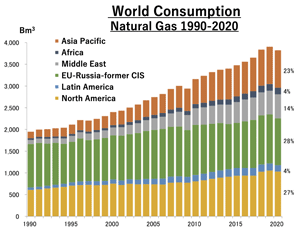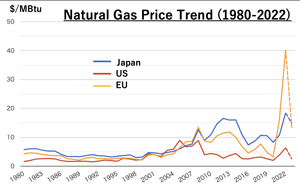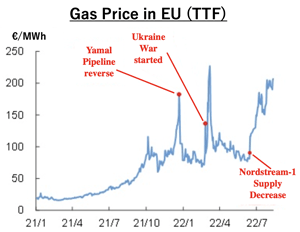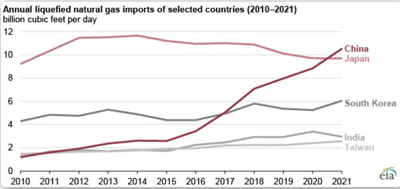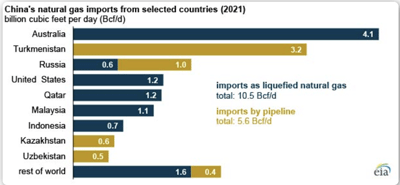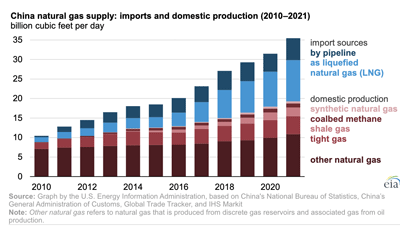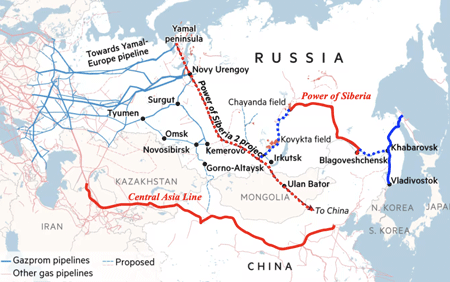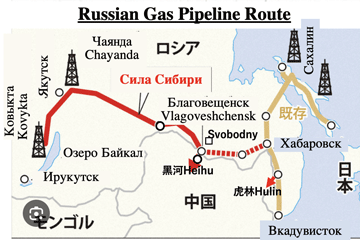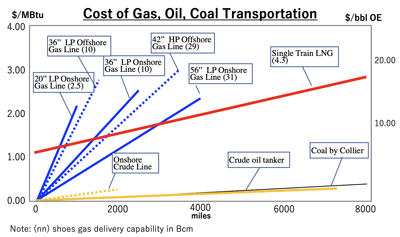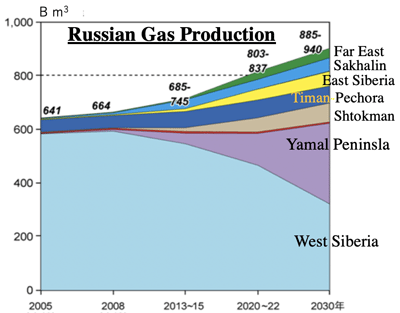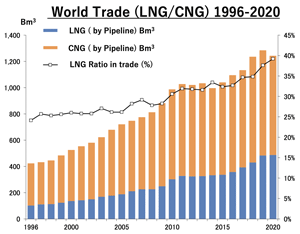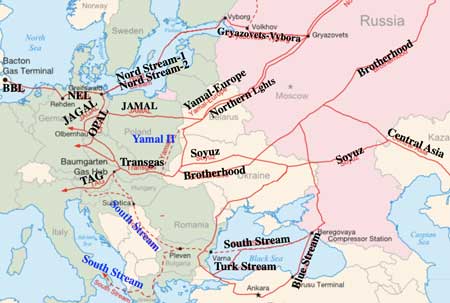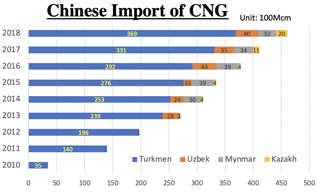>Top 8. Russian Pipelines to Europe:
- Gas Price from Russia: (since 2004 Orange Revolution in Ukraine)
- >Top Historically, Soviet or Russian pipelines were built to export natural gas to Eastern European countries. And in 1968 it was extended to Austria via Brotherhood (constructed in 1967), as the first case of exporting natural gas to the West. This was because natural gas was considered (after oil) as a means of getting hard currency. In 1969, USSR signed with Brant SDR government of West Germany, exchanging West German-made large-diameter pipes (1420mm) for Soviet natural gas. The pipeline called "Northern Lights" was constructed in 1973 from Western Siberia via Belarus. When it was completed export of natural gas began to West Germany, then in 1980 exports began to France.

- >Top Natural Gas transmission in Ukraine:
The system is one of the largest gas transmission systems in the world; which is divided into three corridors: 1) Western transit corridor, 2) Southern transit corridor, and 3) North-South internal corridor.
- Western corridor ("Brotherhood, Братсво") are the Soyuz (Союз) pipeline, the Progress pipeline and Urengoy-Pomary-Uzhhorod pipeline. The Soyuz pipeline, originating from Orenburg gas field, with length 1,567km in Ukrainian section and capacity 26.1Bcm per year. The Progress pipeline, originating from Yamburg gas field with length1,1230km and capacity 28.5Bcm per year. The Urengoy-Pomary-Uzhhorod pipeline, originating from Urengoy gas field, with length 1,160km and capacity 29.7Bcm per year.
- Southern corridor, entering Moldova and Romania: with length 323km and capacity 32Bcm. And after re-entering Ukraine all three pipelines exit to Romania and connect to the Trans-Balkan pipeline, with length 256km and capacity 23.7Bcm per year.
- North-South Russian domestic corridor: during the Ukrainian crisis Russia uses this corridor to supply Dombas regions.
- In 2004 the Ukrainian transit value was estimated at aboutUSD12-13B.
- In 2006 and 2009, Russia cut off the gas supplies from Russia to Ukraine. These incidents were caused by Ukraine's resistance to the raise of gas price by Russia, due to no contract situation between the two countries. Afterwards the price was agreed by the arbitration of EU at the lower level than the international price at the time. This is caused by such background that the pipeline capacity passing through Ukraine is 120Bcm per year, which shared about 70% of Russian total export volume, Ukraine could show stronger position as a major transit country.
- Russia-EU Pipelines:
- >Top "Nord Stream (Северный поток)":
- An offshore natural gas pipeline which runs under the Baltic Sea from Russia to Germany to provide Western Europe. It comprises two projects, NordStream-1 (length 1,222km, completed 2011/11/8, capacity 55Bcm per year) and Nord Stream-2 (completed on 2021/9, total capacity of NS1 & NS2 is 110Bcm) land in Lubmin Germany. The majority is owned by Russia (51%), and is financed by a consortium of Russia, Germany, France, Austria and Netherlands. It was the first pipeline that bypassed Ukraine and Poland to deliver Russian gas directly to West Europe. (Nord Strema-2 was opposed by US, who later imposed sanctions on the consortium companies. Such US sanctions were criticized heavily by German politicians as a serious interference in the internal affairs and sovereignty.
- In 2021 Russia supplied about 45% of natural gas imported by EU.
- Nord Stream-1 (NS1) runs from Vyborg in Russia to Greifswald in Germany, which entered service in 2011.
- Nord Stgream-2 (NS2) runs from Ust-Luga near Estonia, completed in 2021 but did not enter service because Germany withheld permission on 2022/2/22
- From 2022/8/31 Gazprom halted delivery via NS1 indefinitely, officially because of maintenance.
- On 2022/9/26, Explosion was detected from BS2, and 17 hours later the same explosion occurred at NS1. Russia confirmed one of the two NS2 pipes is operable. The leaks are located within EEZ of Denmark and Sweden.
- On 2022/9/27, European gas prices jumped 12% after the news of damaged pipelines.
- >Top "UN Convention on the Law of the Sea"
- Article 79 of the Law states, "All states have the right to lay submarine cables and submarine pipelines on their continental shelves. Coastal states may no obstruct the laying and maintenance of pipelines. The agreement shall be obtained with the consent of the coastal state."
- Traditionally, EU side has promoted market liberalization and supply diversification by drafting the EU Gas Directive (1998) from the standpoint of encouraging free competition in the market, and has been reluctant in promoting long-term contracts, rather focusing on short or medium-term contracts; which was EU's more desirable energy security policy (along with the promotion of renewable energy)
- However, once China appeared on the scene as a long-term purchaser of gas resources from Russia via Altai Pipeline, (as the so-called China Card is effective) EU's has changed their stance and began to pursue long-term and stable purchase contracts; European energy companies (Germany's E.On, France's GdF, Italy's ENI, Tuscan OMV, etc.) have signed with Gazprom of long-term contracts for 20-25 years.
- Regarding the price mechanism, even though it is a long-term contract, negotiations are usually conducted between the parties, taking market trends into consideration. In addition to the gas price negotiations, finances for the pipeline construction and investment for equity of energy companies in partner countries are often proposed.
- >Top Regarding passage of pipelines, Article 7 of the Energy Charter Treaty stipulates the "principle of freedom of transit." Russian, as a transit country for Turkmenistan's gas, must receive appropriate tariff and allow it to pass through. In reality, the products are purchased at the border, which is considered as unfair discrimination. (Russia has signed this treaty, but has not ratified yet.) Russia seems to keep the position of Turkmenistan gas as complementary product.
- However, for Russia economically speaking, increase of gas imports from Central Asia is in competition with the development to East Siberia and Sakhalin gas fields ("Vostok Program"; Kovyka, Chayanda, Sakhalin-3)
- In 2006/4 China and Turkmenistan signed on the pipeline construction and long-term gas supply, which became operative (length 1,833km) in 2014/6 transporting 25Bcm per annum to China. (Until the inauguration of the pipeline, nearly 70% of Turkmenistan's gas exports transited through Russian pipelines.) China's CNPC receives Turkmenistan gas in the Xinjiang Uyghur Autonomous Region, and transports it to Shanghai via the second West-East Pipeline to Shanghai. Construction began in 2006 to extend the pipeline, with plans to transport it up to Guangzhou.
- Starting from 2006/10, Russia purchased gas from Turkmenistan at USD100/Kcm and resale it to China at the similar level. This price is at the border of Uzbekistan, and such trasit tariffs from Uzbekistan, Kazakhstan and Kyrgyzstan are added, so China needs to pay such extra charges.
- In 2008/3, Russia agreed to raise the purchase price of natural gas via Central Asia Pipeline (between China and Turkmenistan) to the same price as Europe (USD305-340/Kcm at that time). Russia is planning to keep the gas as an integral part of Russian gas strategy.
- Turkmenistan possesses the world 4th largest reserves of natural gas, which shares 81% of its total export.
- China has already entered into a contract with Turkmenistan in 2009 at the purchase price of USD195/Kcm, which was lower than Russia's purchase price, but later raised the price to USD260/Kcm in response.
- The key to negotiations depends on superiority and flexibility in "supply capacity," "purchase quantity," and "purchase price," which are the elements of competition.
- The so-called "pipeline geopolitics" is a phenomenon which usually occurs after the pipeline has been constructed, and the main key factors determining pipeline construction are its feasibility, stability, and economy.
|
8.
欧州向けロシア・パイプライン:
- ロシアの天然ガス価格
- 歴史的には、1960年代に、ソ連から東欧諸国への天然ガス輸出のためのPipelineが建設されてきた。(1967, Brotherhood; 1968にはオーストリアまで延伸され、初めて西側へ天然ガスが輸出された。) 天然ガスが石油に次ぐHard currency獲得源とされたことによる。1969年には西独ブラント政権との間で、西独製大口径管とソ連の天然ガスの交換協定が締結され、1973年に西シベリアからベラルーシ経由の大口径(1420mm)でのPipeline "Northern Lights"が完成し、本格的に西独に輸出されるようになり、1980年には仏への輸出も開始された。
- <左図参照>
- ウクライナにおける天然ガスの輸送:
世界最大級のGas Pipeline sytemの一つで、1) Western transit回廊, 2) Southern transit回廊, 3) North-South internal回廊に分かれる
- Western transit回廊 ("Brotherhood, Братсво"): は、Soyuz (Союз) pipeline, Progress pipeline, およびUrengoy -Pomary -Uzhhorod pipelineからなる。Oremburug ガス田を起点とするSoyuz pipelineはウクライナ区間の長さ1,567km、年間輸送量26.1Bcmである。Progress pipeline はYamburg ガス田を起点としてとして、長さ1,120km 年間輸送量28.5Bcm。Urengoy -Pomary -Uzhhorod pipelineはUrengoy ガス田を起点とし、長さ1,160km 年間輸送量29.7Bcmである。
- Southern transit回廊: はモルドバとルーマニア向けで、長さ323km 年間輸送量32Bcm。またウクライナに再入した後、3本のpipelineがルーマニアに向かう。全長256km 年間輸送量23.7BcmのTrans-Balkan pipelineに接続する。
- South-North ロシア国内回廊: ウクライナ危機中、ロシアはドンバス地域への供給にこの回廊を利用。
- 2004には、ウクライナのガス通過料金の価値はUSD120-130億と推定。
- 2006年と2009年にロシアからウクライナへの天然ガス供給が停止するという事件が発生したが、この原因はガス価格の値上げに対しウクライナが抵抗し、無契約状態になったことに伴う供給停止であった。その後合意した価格も、当時の国際価格を下回るものであった。これはウクライナを通過するPipeline容量が120Bcm/yで、ロシアの輸出量の70%もあり、ウクライナは通過国として強気に出たものである。
- Nord Stream Pipeline:
- バルト海の海底をロシアからドイツ経由西欧に供給する天然ガスパイプライン。このプロジェクトは、ドイツのLubminに陸揚げされるNord Stream-1 (NS1; 全長1,222km, 2011/11/8に完成。年間輸送55Bcm)とNord Stream-2 (NS2; NS1と合わせ年間輸送量は110Bcm)の2プロジェクトで構成される。株式の51%はロシアが保有し、ロシア・独・仏・墺・蘭のconsortiumによって資金提供された。これは、ウクライナとポーランドを迂回してロシアの天然ガスを西欧に直接輸送する最初のPipelineとなった。 (NS2については米国が反対し、後にconsortium 企業に
対しても制裁を課した。なおドイツはこの米国による制裁は内政と主権に関する干渉として厳しく批判した。)
- 2021年の段階では、ロシアはEUの天然ガス輸入量の約45%を供給。
- NS1は、ロシアのVyborgからドイツのGreifswald へ向けて輸送され、2011年に完成した。
- NS2は、エストニア近くのUst-Lugaから輸送され、2021年に完成したが、ドイツが2022 /2/22にNS2の許可を保留したため稼働しなかった。
- 2022/8/31よりGazpromは、メンテナンスを理由に、ガス輸送を無期限に停止した。
- 2022/9/26にNS2で爆発が検知され、その17時間後にNS1でも爆発が発生した。ロシアは、NS2の2本のパイプの内1本は稼働可能であることを確認。ガス漏洩場所はデンマークとスウェーデンのEEZ内。
- 2022/9/27 NS1とNS2 Pipeline損傷のニュースを受けて欧州のガス価格が12%上昇した。
- 国連海洋法:
- 国連海洋法79条には、"全ての国は大陸棚に海底cableおよび海底Pipelineを敷設する権利を有する。沿岸国はPipelineの敷設・維持を妨げることはできない。但し、経路の設定については沿岸国の同意を得る"と規定している。
- 従来EU側は、市場での自由競争を推奨する立場からEU Gas Directive (1998)を立案することで、市場の自由化、供給の多様化を進め、長期契約にはむしろ控えて、短中期の契約の方が(再生可能エネルギー推進と合わせて)望ましいエネルギー安全保障政策であるという立場であった。中国が登場すると (いわゆる中国カードが奏効し) たちまち長期契約による供給ソース囲込みの動きが生じた。そして安定供給を確実にする上で、中ロの長期契約の状況(Altai Pipline)に対抗して、欧州エネルギー企業 (独E.On、仏GdF、伊ENI、墺OMVなど) は20-25年の長期契約をGazpromと提携した。
- 価格メカニズムに関しては、長期契約と言えど、通常は市場動向を考慮して当事者間で交渉が行われる。さらにガス価格交渉に加えて、Pipeline建設への資金提供や相手国のエネルギー会社への出資も一緒に提案されることがしばしばある。
- 供給ルートの通過に関しては、エネルギー憲章条約第7条で、"通過の自由の原則"を規定しており、通過国となるロシアはトルクメニスタンのガスに対して適正なタリフを受けて通過させねばならず、国境での買い取りなど不当な差別を強いてはならないとしている。(ロシアはこの条約を署名しながら批准していない。) ロシアは、トルクメニスタンをあくまでロシアのガス生産を補完する立場に置こうとしている。
- 但し、ロシアとしては、経済的には中央アジアからのガス輸入増加は、東シベリアとサハリンのガス田("ボストーク計画"; Kovykta, Chayanda, Sakhalin-3のガス田)を開発することとの競合関係にある。
- 2006/4に中国とトルクメニスタンは Pipeline 建設と長期のガス供給に調印した。2014/6に稼働し(全長1,833km)、25Bcm/年のガスを中国に輸出した。(このPipelineが開通するまで、トルクメニスタンのガス輸出の70%近くがロシアのPipelineを経由していた。) 中国のCNPCはこのガスを新疆ウイグル自治区で受け取り、東西Pipelineを経由して上海に輸送している。この東西Pipelineは広州まで延長する計画(第二"西気東輸"Pipeline)で、2006年に建設が開始された。
- ロシアはトルクメニスタンのガスを2006/10からUSD100/Kcmで購入し、中国に同水準で売り渡した。但し、これはウズベキスタン国境での価格であり、途中ウズベキスタン、カザフスタン、一部キルギスタンの通過タリフも追加されるので、中国の購入価格はかなりの額になる。
- ロシアは、中国・トルクメニスタン間の中央アジアPipelineでの、天然ガスの買取価格については、2008/3に欧州並み価格 (当時はUSD305-340 /Kcm) への引き上げに合意し、中央アジアの天然ガスを引き続きロシアのガス戦略の一貫とする囲い込みを画策。
- トルクメニスタンは、天然ガス埋蔵量は世界第4位で、その輸出総額の81%を占める。
- 中国は、トルクメニスタンに対しては、2009年にはロシアの買取価格より安いUSD195/Kcmで既に契約していたが、その後、USD260/Kcmまで引き上げて対抗している。
- 交渉の鍵は、競争の要素である "供給力", "購入量", "購入価格"の優位性と柔軟性にかかっている。
- "パイプライン地政学"は、通常、パイプラインが建設されてから後追いで起こる現象であり、パイプライン建設を決定する主たる要因は、その実現性、安定性、経済性である。
|
